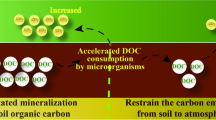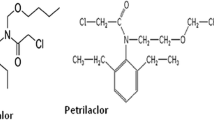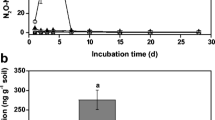Abstract
An experiment was conducted under three levels of atmospheric CO2 [ambient (398 ± 10 μmol mol−1), elevated (570 ± 10 μmol mol−1) and open condition], three levels of temperature (4, 25, and 40 °C) to study the degradation pattern of flubendiamide in soil and also carbon mineralization in soil. Results of this study revealed that flubendiamide was found to persist longer under outdoor condition (T1/2, 177.0 and 181.1 days) than ambient (T1/2, 168.4 and 172.3 days) and elevated condition (T1/2, 159.3 and 155.3 days) at 1 and 10 μg g−1 fortification level, respectively. Results also revealed that flubendiamide dissipated faster at 40 °C (T1/2, 189.4 days) than 25 °C (T1/2, 225.3 days). Slower dissipation was recorded at 4 °C (T1/2, 326.3 days). Thus, increased CO2 levels and temperature following global warming might adversely affect flubendiamide degradation in soil. Laboratory study on microbial biomass carbon (MBC) and carbon mineralization (Cmin) in soil revealed that in des-iodo flubendiamide-treated soils, MBC significantly increased up to 45 days and then decreased. Flubendiamide-treated soil showed a non-significantly decreasing trend of soil MBC with time up to the 15th day of incubation and after 15 days significantly decreased up to 90 days of incubation. In des-iodo flubendiamide-treated soil, the evolution of CO2 decreased up to 45 days, which was increased after 45 days up to 90 days. In flubendiamide-treated soil, CO2 evolution decreased up to 30 days and after 45 days, it increased up to 90 days.






Similar content being viewed by others
References
Bailey SW (2003) Climate change and decreasing herbicide persistence. Pest Manag Sci 60:158–162
Bazot S, Ulff L, Blum H, Nguyen C, Robin C (2006) Effects of elevated CO2 concentration on rhizodeposition from Lolium perenne grown on soil exposed to 9 years of CO2 enrichment. Soil Biol Biochem 38:729–736
Black CA, Evans DD, White JL, Ensminger LE, Clark FE (eds) (1965) Methods of soil analysis, 2nd edn. In Agronomy monograph 9. Madison: Agronomy Society of America and Soil Science Society of America.
Blakemore LC, Searle PL, Daly BK (1987) Methods for chemical analysis of soils. NZ Soil Bureau Scientific Report, series 80. NZ DSIR, New Zealand, p 103
Bloomfield JP, Williams RJ, Gooddy DC, Cape JN, Guha P (2006) Impact of climate change on the fate and behavior of pesticides in surface and ground water—a UK perspective. Sci Total Environ 369:163–177
Bobe A, Cooper JF, Coste CM, Muller MA (1998) Behavior of fipronil in soil under Sahelian plain field conditions. Pestic Sci 52:275–281
Bouyoucos GJ, Cook RL (1967) Measuring the relative humidity of soils at different moisture contents by the gray hydrocal hygrometer. Soil Sci 104:297–305
Carney KM, Hungate BA, Drake BG, Megonigal JP (2007) Altered soil microbial community at elevated CO2 leads to loss of soil carbon. Proc Natl Acad Sci U S A 104:4990–4995
Chatterjee NS, Gupta S, Varghese E (2013) Degradation of metaflumizone in soil: impact of varying moisture, light, temperature, atmospheric CO2 level, soil type and soil sterilization. Chemosphere 90:729–736
Choi JS, Fermanian TW, Wehner DJ, Spomer LA (1988) Effect of temperature, moisture, and soil texture on DCPA degradation. Agrono J 80:108–113
Das SK, Avasthe RK (2015) Biochar as carbon negative in carbon credit under changing climate. Curr Sci 109:1223
Das SK, Mukherjee I (2011) Effect of light and pH on persistence of flubendiamide. Bull Environ Contam Toxicol 87:292–296
Das SK, Mukherjee I (2012a) Effect of moisture and organic manure on persistence of flubendiamide in soil. Bull Environ Contam Toxicol 88:515–520
Das SK, Mukherjee I (2012b) Flubendiamide transport through packed soil columns. Bull Environ Contam Toxicol 88:229–233
Das SK, Mukherjee I (2014) Influence of microbial community on degradation of flubendiamide in two Indian soils. Environ Monit Assess 186:3213–3219
Das SK, Mukherjee I, Das SK (2012) Dissipation of flubendiamide in/on okra [Abelmoschus esculenta (L.) Moench] fruits. Bull Environ Contam Toxicol 88:381–384
Das SK, Mukherjee I, Kumar A (2015) Effect of soil type and organic manure on adsorption–desorption of flubendiamide. Environ Monit Assess 187:403. doi:10.1007/s10661-015-4623-2
De Graaff M, Van Groenigen K, Six J (2006) Interactions between plant growth and soil nutrient cycling under elevated CO2: a meta-analysis. Global Change Biol 12:2077–2091
Doran JW, Parkin TB (1994) Defining and assessing soil quality. In: Doran JW, Coleman DC, Bezdicek DF, Stewart BA (eds) Defining soil quality for sustainable environment, vol Special pub 35. Soil Sci Soc Am, Inc., Madison
Drigo B, Kowalchuk GA, van Veen JA (2008) Climate change goes underground: effects of elevated atmospheric CO2 on microbial community structure and activities in the rhizosphere. Biol Fertil Soils 44:667–679
Guerin T (1999) Natural attenuation of a low mobility chlorinated insecticide in low-level and high-level contaminated soil: a feasibility study. Remediation J 9:51–63
Handa SK, Agnihotri NP, Kulshreshtha G (1999) Pesticide residues: significance, management and analysis. Research Periodicals and Book Publishing House, Texas
IPCC (2007) Climate Change 2007: The Physical Sciences Basis. Contribution of Working Group I to the Fourth Assessment Report of the Intergovernmental Panel on Climate Change, pp. 847–940. Cambridge University Press, Cambridge, UK.
Jackson ML (1967) Soil chemical analysis. Prentice Hall, New Delhi
Janus L, Angeloni N, McCormack J, Rier S, Tuchman N, Kelly J (2005) Elevated atmospheric CO2 alters soil microbial communities associated with trembling aspen (Populus tremuloides) roots. Microbial Ecology 50:102–109
Joergensen RG (1996) The fumigation–extraction method to estimate soil microbial biomass: calibration of the kEC value. Soil Biol Biochem 28:25–31
Kaur I, Mathur RP, Tandon SN, Dureja P (1998) Persistence of endosulfan (technical) in water and soil. Environ Technol 19:115–119
Lesaulnier C, Papamichail D, McCorkle S, Ollivier B, Skiena S, Taghavi S (2008) Elevated atmospheric affects soil microbial diversity associated with trembling aspen. Environ Microb 10:926–941
Li X, Han S, Guo Z, Shao D, Xin L (2010) Changes in soil microbial biomass carbon and enzyme activities under elevated CO2 affect fine root decomposition processes in a Mongolian oak ecosystem. Soil Biol Biochem 42:1101–1107
Masaki T, Yasokawa N, Tohnishi M, Motoba K, Hirooka T (2006) Flubendiamide, a novel Ca2+ channel modulator, reveals evidence for functional cooperation between Ca2+ pumps and Ca2+ release. Mol Pharmacol 69:1733–1739
Morishima N, Iigaya M (1995) Photo degradation of (Phenyl-UL-14C) KTU 3616 in water. Interner Bericht der Nihon Bayer Agrochem K K, Yuki, Japan
Sengupta D, Aktar W, Purkait S, Ganguly M (2009) Impact of quinalphos on microbial biomass and activities in tropical clay loam soil. Electron J Environ Agric Food Chem 8(11):1127–1135
Starner K, Kuivila KM, Jennings B, Moon GE (1999) Degradation rates of six pesticides in water from the Sacramento River, California, U.S. geographical survey toxic substances hydrology program: proceeding of the technical meeting, Charleston, South Carolina. http://ca.water.usgs.gov/archive/reports/wrir994018/CA-0216.pdf. Accessed on 20th May 2015.
Sujatha KB, Uprety DC, Rao DN, Rao PN, Dwivedi N (2008) Up-regulation of photosynthesis and sucrose-P synthase in rice under elevated carbon dioxide and temperature conditions. Plant Soil Environ 54:155–162
Tohnishi M, Nakao H, Furuya T, Fujioka S, Kodama H, Hirooka T, Nishimatsu T (2005) Flubendiamide—a novel insecticide highly active against Lepidopteron insect pests. J Pestic Sci 30:354–360
Torstenssen L, Stenstorm J (1986) Basic respiration rate as a tool for prediction of pesticide persistence in soil. Toxic Assess 1:57–72
Tu CM (1992) Effect of some herbicides on activities of microorganisms and enzymes in soil. J Environ Sci Heal B 27:695–709
Vance ED, Brookes PC, Jenkinson DS (1987) An extraction method for measuring soil microbial biomass. Soil Biol Biochem 19:703–707
Voos G, Groffman PM (1997) Relationship between microbial biomass and dissipation of 2, 4-D and dicamba in soil. Biol Fertil Soils 24:106–110
Walker A, Jurado-Exposito M, Bending GD, Smith VJR (2001) Spatial variability in the degradation rate of isoproturon in soil. Environ Pollut 111:407–415
Walkley, Black CA (1965) Organic carbon: methods of soil analysis (parts 1 and 2). Agronomy 9:1367–1378, American. Society of Agronomy, Inc., Madison, WI
Watters FL, White NDG, Cote D (1983) Effect of temperature on toxicity and persistence of three pyrethroids insecticides applied to fir plywood for the control of the red flour beetle (Coleopteran: Tenebrionidae). J Eco Entomol 76:11–16
Williams JR, Richardson CW, Griggs RH (1992) The weather factor: incorporating weather variance into computer simulation. Weed Technol 6:731–735
Xing B, Pignatello JJ (1997) Dual-mode sorption of low-polarity compounds in glassy poly (vinyl chloride) and soil organic matter. Environ Sci Technol 31:792–799
Zelles L, Scheunert I, Korte F (1985) Side effects of some pesticides on non-target soil microorganisms. J Environ Sci Heal B 20:457–488
Zibilski LM (1994) Carbon mineralization. In: Bingham JM, Mickelson SH (eds) ‘Methods of soil analysis’, Part 2. Microbiological and biochemical properties. SSSA, Book Series No. 5. ASA, SSSA, Madison.
Acknowledgments
The first author thanks Director, IARI, New Delhi, and Head, Division of Agricultural Chemicals, IARI, New Delhi, for providing support and facilities for the research work.
Author information
Authors and Affiliations
Corresponding author
Additional information
Responsible editor: Zhihong Xu
Rights and permissions
About this article
Cite this article
Mukherjee, I., Das, S.K. & Kumar, A. Degradation of flubendiamide as affected by elevated CO2, temperature, and carbon mineralization rate in soil. Environ Sci Pollut Res 23, 19931–19939 (2016). https://doi.org/10.1007/s11356-016-7145-8
Received:
Accepted:
Published:
Issue Date:
DOI: https://doi.org/10.1007/s11356-016-7145-8




